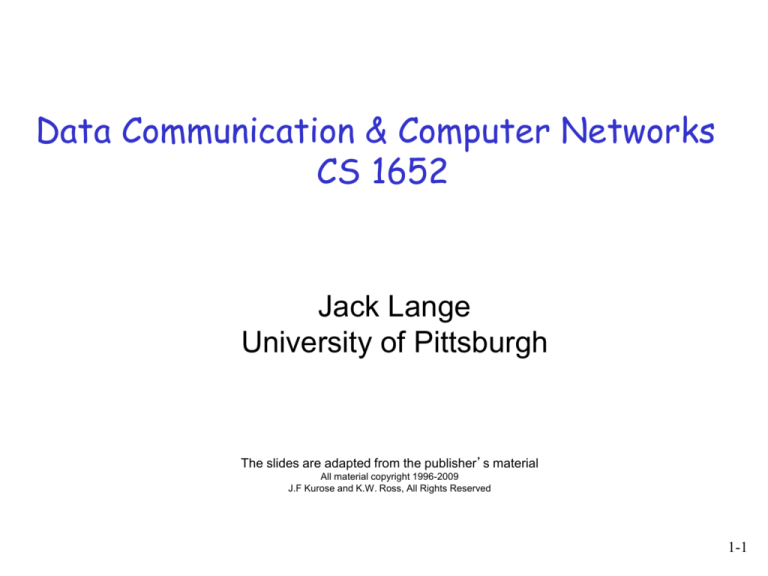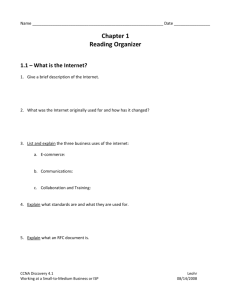
Data Communication & Computer Networks
CS 1652
Jack Lange
University of Pittsburgh
The slides are adapted from the publisher’s material
All material copyright 1996-2009
J.F Kurose and K.W. Ross, All Rights Reserved
1-1
Course Objectives
Understand modern data communication
systems and computer networks
Understand the key concepts
How they are designed & implemented
How they are operated
How they are likely to evolve in the future
Course Approach
Top-down : from what’s familiar to nuts and bolts
The Internet as the main focus
Hands-on experience on networked systems
1-2
Administrativia
Instructor: Jack Lange
Email: jacklange@cs.pitt.edu
Office: Sennott Square #5407
Office Hours: Weds. 2-4PM
Teaching Assistant: TBD
1-3
Communication
Course homepage
http://www.cs.pitt.edu/~jacklange/teaching/cs1652-f13/
Announcements, clarifications, corrections
Additional resources for projects
Google Group
http://groups.google.com/group/pitt-cs1652-f13
pitt-cs1652-f13@googlegroups.com
Private discussion group
• Open venue for class discussions and questions
Based on email (Pitt addresses)
• Email me if you want to use a different one
TextBooks
Computer Networking: A Top-Down Approach
James Kurose and Keith Ross
Fifth/Sixth Edition, Addison Wesley, 2010
TCP/IP Illustrated, Volume I: The Protocols
Richard Stevens
Addison Wesley, 1994
Class meeting times
Lecture
Tues/Thurs: 4:00-5:15PM
Sennott Square, Rm. 6110
Lab Sessions
Sennott Square, Rm. 5506
Periodically replace lectures
Hands on exercises
Answer project question
Hopefully guest lectures
1-6
Networking Lab
Sennott Square, Rm. 5506
16 Linux machines (Fedore Core 13)
Login: Hopefully will be your Pitt login
Available for projects
• Can use other machines, but…
• Must work on lab equipment
Dual NICS
1 internal network interface to be used for projects
1 external network interface for external access
1-11
Homework
Reading assignments
Expected to read before each class
Homework
4 problem sets spaced over semester
Projects
Web server (20%)
TCP (50%)
Routing (30%)
Check Syllabus!
Grading
Grading
Midterm (20%)
Final (20%)
4 Homework (10%)
3 Projects (50%)
Late policy
Submit by midnight of the due date
10% penalty for every day late
Projects
Work in groups of 2
C/C++ is required
Lot of work, but will be worth it
Build a TCP stack and a Web server that runs on it
IP routing
Highly Recommended: OS or having some
familiarity with Unix systems programming,
preferably in C or C++
Minet is in C++
BUILDING software is 50% of the grade of this class
1-9
Today’s topic
Computer Networks Overview
What’s the Internet?
• Nuts and bolts vs. service view
What’s a protocol?
• A set of rules between communicating entities
Network edge/core
• Hosts, access networks, physical media
• Packet switching/circuit switching, Internet structure
Goal
Get “feel” and terminology
More depth, detail later in course
1-12
What is the internet?
Flows, packets, and bits
Optical light, electricity, and radio waves
Servers, clients, and peers
Hosts, switches, and routers
What’s the Internet: Hardware view
millions of connected
PC
server
computing devices:
hosts = end systems
wireless
laptop
cellular
smartphone
access
points
wired
links
communication links
fiber, copper, radio,
satellite
transmission rate =
bandwidth
Mobile network
Global ISP
Home network
Regional ISP
Institutional network
routers: forward
router
packets (chunks of
data)
1-13
What’s a protocol?
human protocols:
“what’s the time?”
“I have a question”
introductions
… specific msgs sent
… specific actions
taken when msgs
received, or other
events
network protocols:
machines rather than
humans
all communication activity in
Internet governed by
protocols
protocols define format, order
of msgs sent and received
among network entities, and
actions taken on msg
transmission, receipt
1-17
What’s a protocol?
a human protocol and a computer network protocol:
TCP connection
request
Hi
Hi
TCP connection
response
Got the
time?
2:00
Get http://www.awl.com/kurose-ross
time
<file>
1-18
Where are we?
What’s the Internet?
Nuts and bolts vs. service view
What’s the protocol?
Network edge/core
Hosts, access networks, physical media
Packet switching/circuit switching, Internet
structure
1-19
A closer look at network structure:
network edge:
applications and hosts
access networks,
physical media: wired,
wireless communication
links
network core:
interconnected routers
network of networks
Edge routers “uplink” to
core routers
1-20
The network edge: Traditionally where the action is
end systems (hosts):
run application programs
e.g. Web, email
at “edge of network”
peer-peer
client/server model
client host requests, receives service
from always-on server
e.g. Web browser/server; email
client/server
client/server
peer-peer model:
minimal (or no) use of dedicated
servers
e.g. Skype, BitTorrent
1-21
Internet structure: network of networks
roughly hierarchical
at center: “tier-1” ISPs (e.g., Verizon, Sprint, AT&T,
NTT, Quest, Level3, Global Crossing, Tata, Savvis,
TeliaSonera), national/international coverage
treat each other as equals
Tier-1
providers
interconnect
(peer)
privately
Tier 1 ISP
Tier 1 ISP
Tier 1 ISP
1-13
Internet structure: network of networks
“Tier-2” ISPs: smaller (often regional) ISPs
Connect to one or more tier-1 ISPs, possibly other tier-2 ISPs
Tier-2 ISP pays
tier-1 ISP for
connectivity to
rest of Internet
tier-2 ISP is
customer of
tier-1 provider
Tier-2 ISP
Tier-2 ISP
Tier 1 ISP
Tier 1 ISP
Tier-2 ISP
Tier 1 ISP
Tier-2 ISPs
also peer
privately with
each other.
Tier-2 ISP
Tier-2 ISP
1-15
Internet structure: network of networks
“Tier-3” ISPs and local ISPs
last hop (“access”) network (closest to end systems)
local
ISP
Local and tier3 ISPs are
customers of
higher tier
ISPs
connecting
them to rest of
Internet
Tier 3
ISP
Tier-2 ISP
local
ISP
local
ISP
local
ISP
Tier-2 ISP
Tier 1 ISP
Tier 1 ISP
Tier-2 ISP
local
local
ISP
ISP
Tier 1 ISP
Tier-2 ISP
local
ISP
Tier-2 ISP
local
ISP
1-16
Internet structure: network of networks
a packet passes through many networks!
local
ISP
Tier 3
ISP
Tier-2 ISP
local
ISP
local
ISP
local
ISP
Tier-2 ISP
Tier 1 ISP
Tier 1 ISP
Tier-2 ISP
local
local
ISP
ISP
Tier 1 ISP
Tier-2 ISP
local
ISP
Tier-2 ISP
local
ISP
1-17
Tier-1 ISP: e.g., Sprint
POP: point-of-presence
to/from backbone
peering
…
….
…
…
…
to/from customers
1-14
What’s the Internet: Software-ish view
protocols control sending,
Mobile network
receiving of msgs
e.g., TCP, IP, HTTP, Skype,
Ethernet
Provides meaning
Internet standards
Global ISP
RFC: Request for comments
IETF: Internet Engineering Task
Force
Home network
Regional ISP
Institutional network
Internet: “network of networks”
loosely hierarchical
public Internet versus private
intranet
1-15
What’s the Internet: Service view
communication infrastructure
enables distributed
applications:
Web, VoIP, email, games,
e-commerce, file sharing
communication services
provided to apps:
reliable data delivery from
source to destination
“best effort” (unreliable)
data delivery
1-16
Access networks and physical media
Q: How to connect end
systems to edge
router?
residential access nets
institutional access
networks (school,
company)
mobile access networks
Keep in mind:
bandwidth (bits per
second) of access
network?
shared or dedicated?
1-22
Ethernet Internet access
100 Mbps
Institutional
router
100 Mbps
To Institution’s
ISP
Ethernet
switch
1 Gbps
100 Mbps
server
Typically used in companies, universities, etc
10 Mbps, 100Mbps, 1Gbps, 10Gbps Ethernet
Today, end systems typically connect into Ethernet
switch
1-32
Wireless access networks
shared wireless access network
connects end system to router
via base station aka “access point”
wireless LANs:
802.11b/g (WiFi): 11 or 54 Mbps
802.11n: ~450Mbps
router
base
station
wider-area wireless access
provided by telco operator
~1Mbps over cellular system
(EVDO, HSDPA, 3G)
next up: WiMAX (10’s Mbps) over
wide area
mobile
hosts
1-33
Digital Subscriber Line (DSL)
Existing phone line:
0-4KHz phone; 4-50KHz
upstream data; 50KHz-1MHz
downstream data
home
phone
Internet
DSLAM
telephone
network
splitter
DSL
modem
home
PC
central
office
Also uses existing telephone infrastruture
up to 1 Mbps upstream
up to 8 Mbps downstream
dedicated physical line to telephone central office
1-24
Residential access: cable modems
Diagram: http://www.cabledatacomnews.com/cmic/diagram.html
1-26
Cable Network Architecture: Overview
Typically 500 to 5,000 homes
cable headend
cable distribution
network (simplified)
home
1-27
Cable Network Architecture: Overview
server(s)
cable headend
cable distribution
network
home
1-28
Cable Network Architecture: Overview
cable headend
cable distribution
network (simplified)
home
1-29
Cable Network Architecture: Overview
FDM (next class):
V
I
D
E
O
V
I
D
E
O
V
I
D
E
O
V
I
D
E
O
V
I
D
E
O
V
I
D
E
O
D
A
T
A
D
A
T
A
C
O
N
T
R
O
L
1
2
3
4
5
6
7
8
9
Channels
cable headend
cable distribution
network
home
1-30
Fiber to the Home (FTTH)
ONT
optical
fibers
Internet
OLT
ONT
optical
fiber
central office
optical
splitter
ONT
Optical links from central office to the home
Two competing optical technologies:
Passive Optical Network (PON) – e.g. Verizon FIOS
Active Optical Network (AON) – Switched Ethernet
Much higher Internet rates; fiber also carries
television and phone services
1-31
Home networks
Typical home network components:
DSL or cable modem
router/firewall/NAT
Ethernet
wireless access
point
to/from
cable
headend
cable
modem
router/
firewall
Ethernet
wireless
laptops
wireless
access
point
1-34
Physical media
Bit: propagates between
transmitter/rcvr pairs
physical link: what lies
between transmitter &
receiver
guided media:
signals propagate in solid
media: copper, fiber, coax
Twisted Pair (TP)
two insulated copper
wires
Category 3: traditional
phone wires, 10 Mbps
Ethernet
Category 5:
100Mbps Ethernet
unguided media:
signals propagate freely,
e.g., radio
1-35
Physical media: coax, fiber
Coaxial cable:
two concentric copper
conductors
bidirectional
baseband:
single channel on cable
• Digital signal
legacy Ethernet
Fiber optic cable:
glass fiber carrying light pulses,
each pulse a bit
high-speed operation:
high-speed point-to-point
transmission (e.g., 10’s-100’s Gps)
low error rate: repeaters spaced
far apart ; immune to
electromagnetic noise
broadband:
multiple channels on cable
• Analog Signal
HFC
1-36
Physical media: radio
signal carried in
electromagnetic spectrum
no physical “wire”
bidirectional
propagation environment
effects:
Radio link types:
terrestrial microwave
e.g. up to 45 Mbps channels
LAN (e.g., Wifi)
11Mbps, 54 Mbps
wide-area (e.g., cellular)
3G cellular: ~ 1 Mbps
reflection
obstruction by objects
satellite
interference
Kbps to 45Mbps channel (or multiple
smaller channels)
270 msec end-end delay
geosynchronous versus low altitude
1-37
Summary
The Internet can be defined as
A set of hosts running distributed applications
communicating via routers
Infrastructure providing popular services
Protocols define the message formats, orders,
actions on transmission and reception
Access networks: at the network edge
Residential (dial-up, DSL, Cable, FTTH)
Institutional (Ethernet)
Wireless (Wi-fi, WiMAX)
1-38
Cable modems
Does not use telephone infrastructure
Instead uses cable TV infrastructure
HFC: hybrid fiber coax
asymmetric: up to 30Mbps downstream, 2
Mbps upstream
network of cable and fiber attaches homes to
ISP router
homes share access to router
unlike DSL, which has dedicated access
1-25




